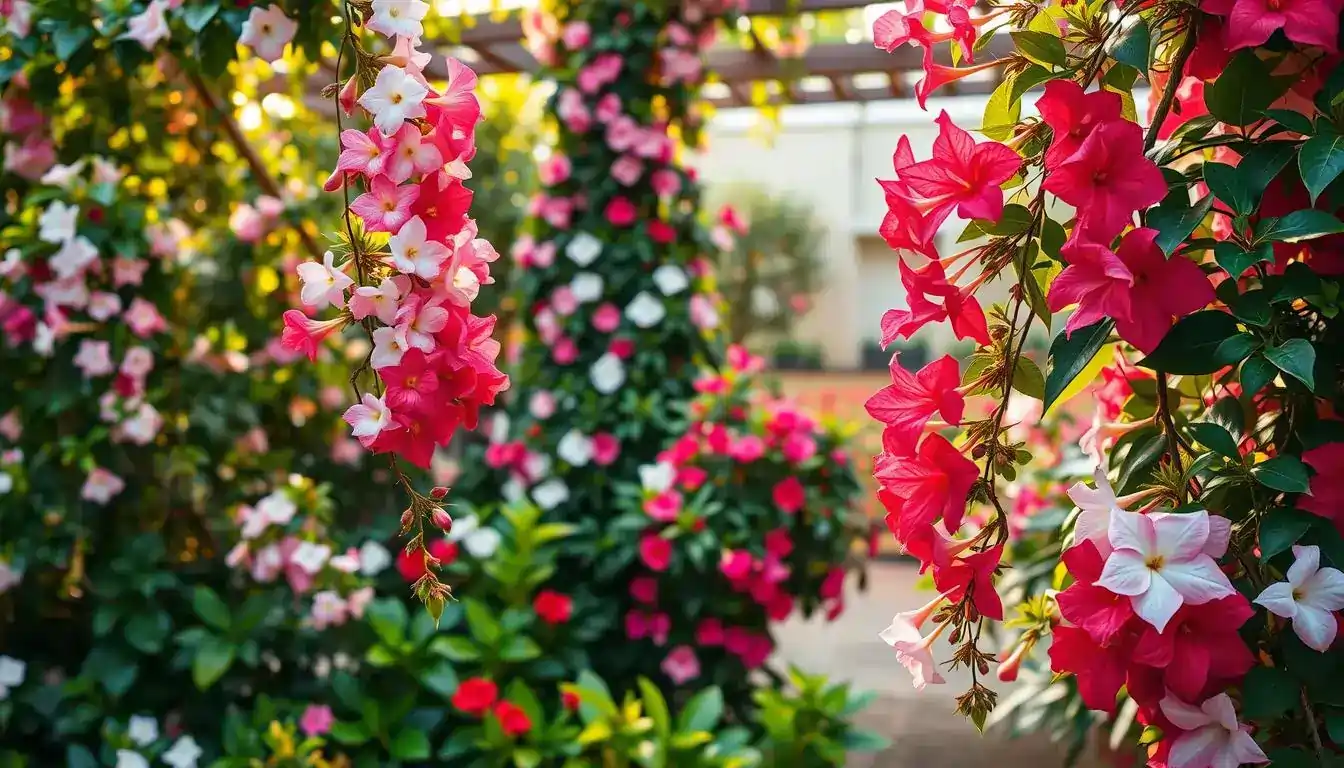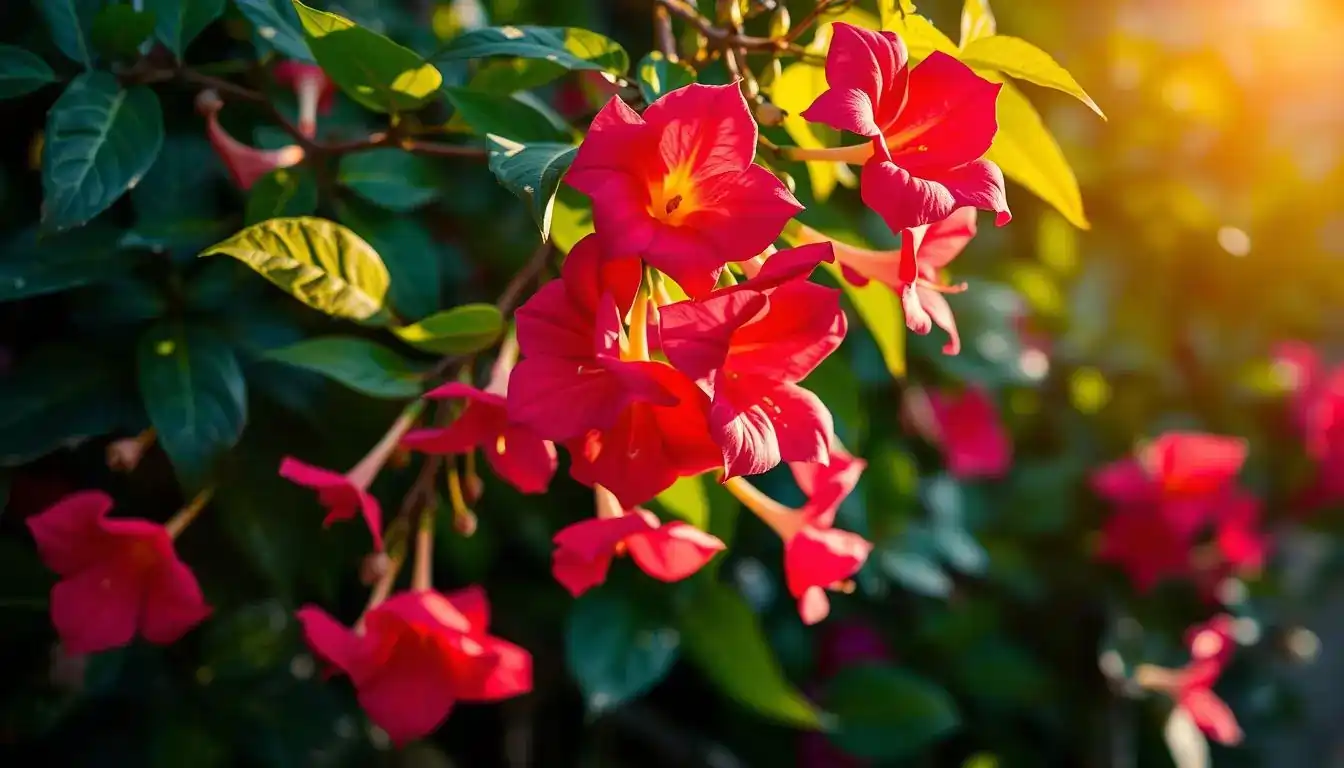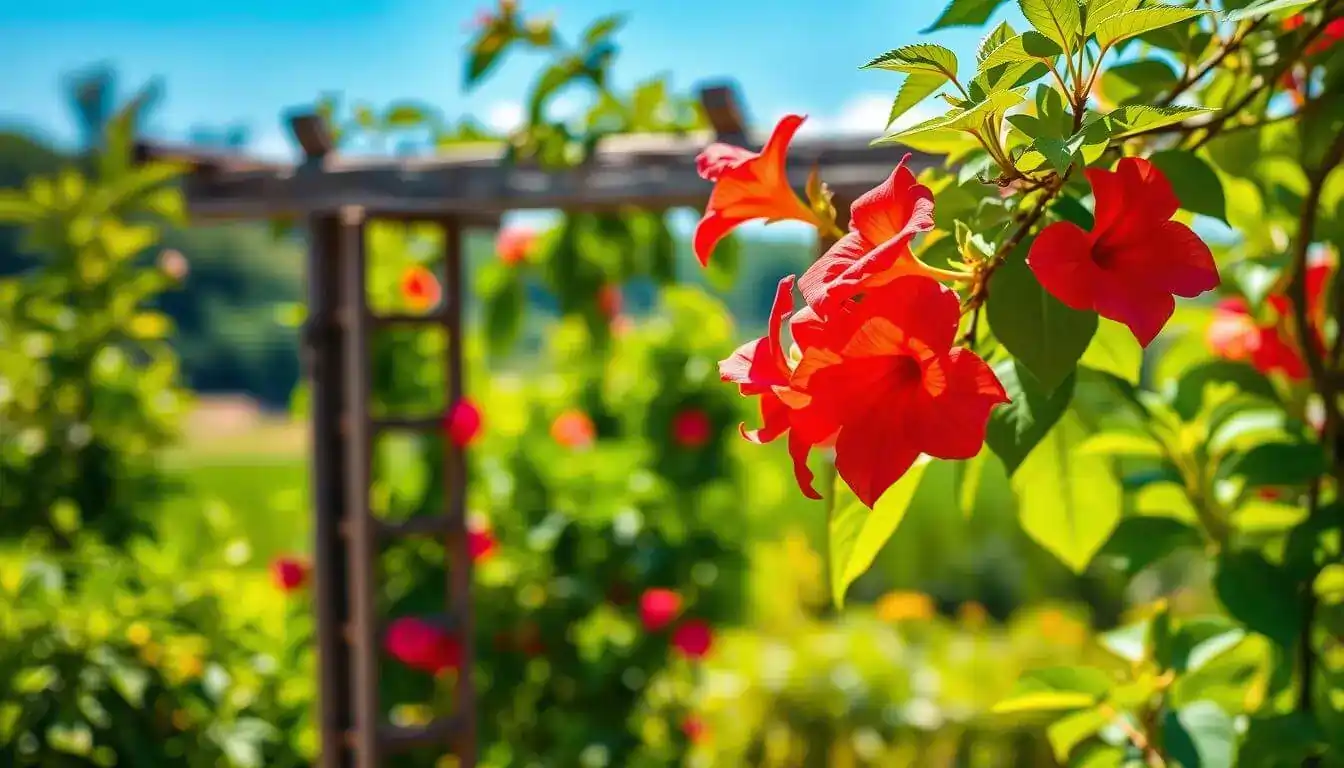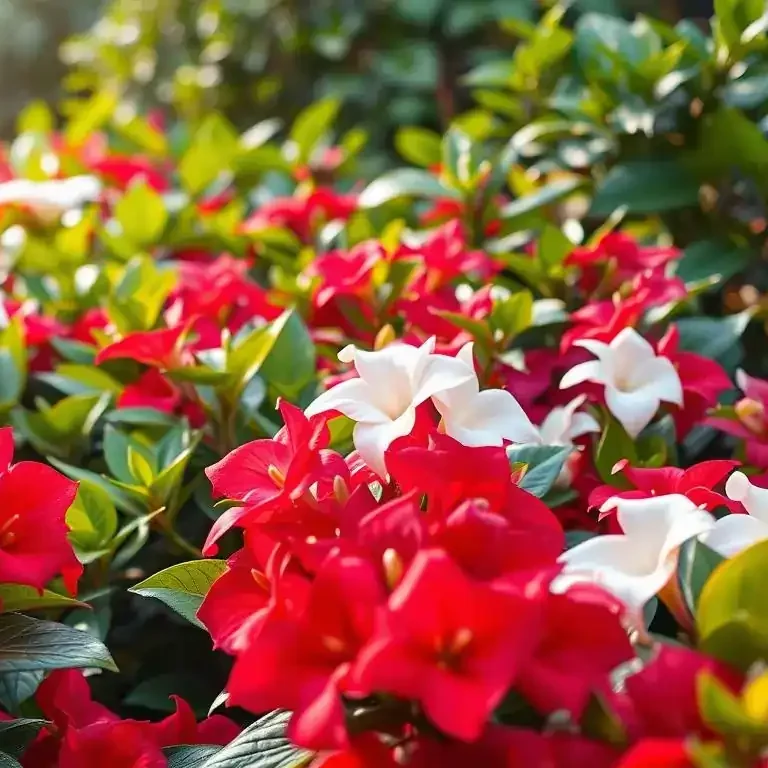Adding a touch of tropical beauty to your garden is easy with the stunning Mandevilla plant. Known for its vibrant flowers and lush foliage, this versatile climber can elevate any outdoor space, bringing a burst of color and elegance.
With numerous varieties available, selecting the right Mandevilla plant can be challenging. Understanding the different types, their characteristics, and care requirements is essential for making an informed decision.
By exploring the various Mandevilla plant varieties, you can choose the perfect one to enhance your garden’s beauty and ensure it thrives in your specific climate.
Key Takeaways
- Understanding the different types of mandevilla varieties
- Characteristics of various mandevilla types
- Care requirements for optimal growth
- Choosing the right variety for your climate
- Tips for enhancing your garden’s beauty with mandevilla
All About Mandevilla Plants
The mandevilla plant is a versatile and beautiful addition to any garden. With its origins in the tropical regions of Central and South America, this plant thrives in warm, humid environments with plenty of sunlight.
Origin and Natural Habitat
Mandevilla plants are native to the tropical regions of Central and South America, where they grow in warm, humid climates with abundant sunlight. They are typically found twining up trees or other supports. To grow mandevilla successfully, you need to replicate these conditions.
General Characteristics
Characterized by their large, trumpet-shaped flowers and dark green leaves, mandevilla plants are a popular choice for gardeners looking to add a tropical touch. The flowers come in various colors, including red, pink, and white, making them a versatile option for different garden designs.
Benefits of Growing Mandevilla
Growing mandevilla can be rewarding, as it attracts pollinators and adds vibrant color to your garden. By understanding its basic needs, including the right soil, watering, and fertilization, you can enjoy the beauty of mandevilla in your garden. To learn how to grow mandevilla plant, it’s essential to provide the right conditions.
Popular Mandevilla Plant Varieties

With a range of colors and forms, mandevilla plants offer gardeners numerous options for adding beauty to their outdoor spaces. Whether you’re looking for a bold statement or a subtle accent, there’s a mandevilla variety to suit your needs.
Red Varieties
Red mandevilla varieties are perfect for adding a dramatic touch to your garden. Two popular options include:
Red Riding Hood
This variety is known for its vibrant red flowers and compact growth habit, making it ideal for smaller gardens or containers.
Sundaville Red
Sundaville Red is another striking red variety, recognized for its large, trumpet-shaped flowers and vigorous growth.
Pink Varieties
For a softer, more romantic look, consider pink mandevilla varieties. Some popular choices are:
Alice du Pont
Alice du Pont is a well-known pink mandevilla, cherished for its beautiful, fragrant flowers and robust growth.
Pink Parfait
This variety offers a delicate pink hue and is suitable for a variety of garden settings, from trellises to hanging baskets.
White Varieties
White mandevilla varieties provide an elegant and subtle option for gardeners. Notable white varieties include:
White Delight
White Delight is a popular choice for its pure white flowers and versatility in garden design.
Bride’s Cascade
This variety is known for its cascading growth habit and beautiful white blooms, making it perfect for hanging baskets or containers.
Unique and Hybrid Varieties
Beyond the traditional red, pink, and white varieties, there are several unique and hybrid mandevillas that offer distinct characteristics. Some examples include:
Sun Parasol Giant
This variety is recognized for its exceptionally large flowers and vigorous growth, making it a standout in any garden.
Tropical Dream
Tropical Dream is a hybrid variety that combines the best traits of different mandevilla species, offering a unique blend of flower size, color, and growth habit.
To help you better understand the different characteristics of these mandevilla varieties, here’s a summary table:
| Variety | Flower Color | Growth Habit |
| Red Riding Hood | Red | Compact |
| Sundaville Red | Red | Vigorous |
| Alice du Pont | Pink | Robust |
| Pink Parfait | Pink | Versatile |
| White Delight | White | Versatile |
| Bride’s Cascade | White | Cascading |
| Sun Parasol Giant | Various | Vigorous |
| Tropical Dream | Various | Hybrid |
How to Choose the Right Mandevilla for Your Garden

Selecting the perfect mandevilla for your garden involves a thoughtful consideration of several key factors. Your choice will significantly impact how well the plant thrives and how much enjoyment you derive from it.
Climate Considerations
Mandevilla plants are generally warm climate lovers and can be sensitive to frost. If you live in an area with cooler temperatures, you’ll need to take special precautions to protect your mandevilla during the winter months. Understanding your local climate is the first step in choosing a variety that will flourish.
Space and Growing Conditions
Assessing your garden’s growing conditions is crucial. Mandevilla plants require adequate sunlight and well-draining soil to thrive. Consider the amount of sunlight your garden receives and the quality of your soil when making your selection.
Growth Habit: Vining vs. Bush Types
Mandevilla plants come in two main growth habits: vining and bush types. Vining types require support as they grow, while bush types are more compact. The table below highlights the key differences between these two types to help you decide.
| Characteristics | Vining Type | Bush Type |
| Growth Habit | Climbing, requires support | Compact, bushy |
| Space Requirements | More space or trellis needed | Less space required |
| Care Requirements | Training needed | Easier to maintain |
Color and Aesthetic Preferences
Finally, consider the color and aesthetic you wish to achieve in your garden. Mandevilla plants come in a variety of colors, including red, pink, and white. Choose a variety that complements your garden’s overall design and your personal taste.
By considering these factors, you can select a mandevilla plant that not only thrives in your garden but also enhances its beauty. Proper mandevilla care will ensure your plant remains healthy and vibrant throughout the growing season.
Essential Mandevilla Plant Care Guide

The key to a healthy and blooming mandevilla lies in proper care. To ensure your mandevilla thrives, it’s crucial to understand its specific needs, from soil and watering requirements to pruning and propagation techniques.
Soil and Watering Requirements
Mandevilla plants prefer well draining soil to prevent root rot. Use a mix that includes perlite or sand to enhance drainage. Water your mandevilla when the top inch of soil feels dry to the touch. Avoid overwatering, as this can lead to root problems.
Soil pH: Mandevilla prefers a slightly acidic to neutral soil pH, ranging from 6.0 to 7.0.
Light and Temperature Needs
Mandevilla plants require full sun to partial shade. They thrive in temperatures between 65°F and 90°F (18°C to 32°C). Protect your mandevilla from frost, as it is sensitive to cold temperatures.
Fertilizing Schedule
Feed your mandevilla with a balanced fertilizer during the growing season (spring and summer). Dilute the fertilizer to half the recommended strength to avoid burning the roots.
Pruning and Training Techniques
Prune your mandevilla regularly to encourage bushy growth and more blooms. Remove any dead or damaged stems, and train the vines to climb up trellises or other supports.
Overwintering Your Mandevilla
In areas with cold winters, bring your mandevilla indoors or to a protected area to overwinter. Reduce watering and fertilizing during this period, as the plant is dormant.
Propagation Methods
Mandevilla can be propagated through stem cuttings. Take 4-6 inch cuttings from the tip of a stem, remove lower leaves, and plant them in moist soil. Keep the soil warm until roots develop.
| Care Aspect | Description | Tips |
| Soil | Well-draining mix | Include perlite or sand |
| Watering | Water when top inch dry | Avoid overwatering |
| Light | Full sun to partial shade | Protect from frost |
| Fertilizing | Balanced fertilizer | Dilute to half strength |
Conclusion
With the right Mandevilla variety for your garden, you’re one step closer to enjoying its vibrant blooms. To keep your Mandevilla healthy and thriving, regular care is essential. Be mindful of potential mandevilla plant diseases and mandevilla plant pests that can harm your plant. Inspect your plant regularly, and take action promptly if you notice any issues. Proper watering, fertilization, and pruning will also help prevent problems. By following these care tips, you’ll be able to enjoy your Mandevilla’s beautiful flowers for years to come.
As you care for your Mandevilla, remember that a little attention goes a long way. With the right care and attention, your Mandevilla will reward you with stunning blooms that add a tropical touch to your garden.

